Improving Online Cookware Store Conversion Rate: 11 Real-World Examples


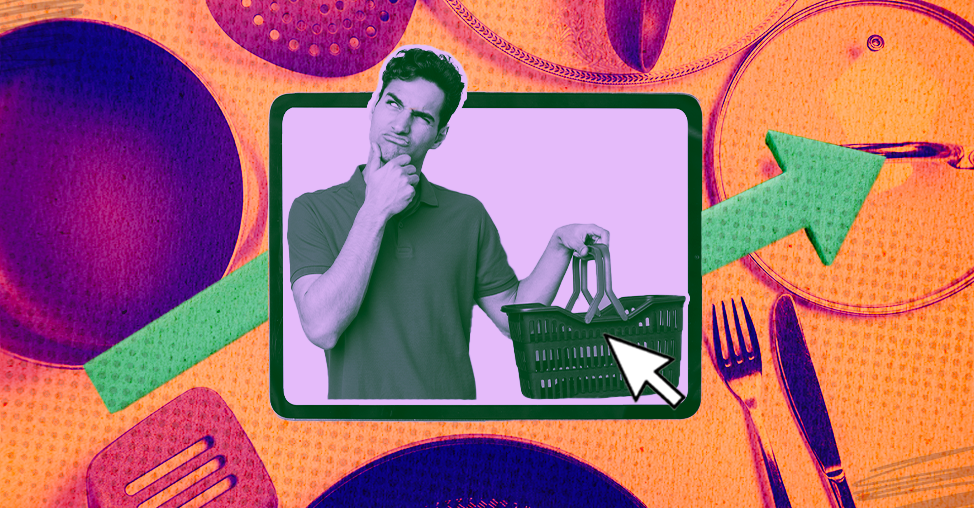
Between 2024 and 2030, the cookware industry is all set to see a CAGR of 7.3%.
The reasons behind this are multifarious, but in a snapshot the biggest eCommerce cookware trends in and beyond 2025 seem to include the following:
👉 As the cookware niche grows, more products are calling out to newbies and those ready to try more innovative ways of cooking — enhancing the customer base significantly
👉 More shoppers in the US are making informed decisions as far as cookware goes, which goes hand in hand with trends like modular kitchens
👉 Along with an avid interest in sustainability in general, cooking enthusiasts seem to be increasingly moving towards eco-cookware that come without adhesives, coatings and polymers
👉 Gifting continues to be a big driver as far as eCommerce cookware products go, and stores that are optimizing to enable this, are definitely seeing more conversions
👉 While functional cookware still seems to play a big role in the US market, more shoppers are making a beeline for products that are high on aesthetics, colors and design.
Now, with that, let’s look at a bunch of cookware store optimization strategies that can put your brand before the rest.
We want to know what’s on our plate, and it’s 2025, so in a way, we also want to know what went into making what’s on our plate — and clearly we’re not just talking about ingredients here.
For seasoned cooks and bakers, it’s imperative that they put their trust in a cookware brand first.
And when you see it through the lens of a high per product price in general, you also see why it’s totally justified.
To use this tactic to optimize your online kitchen store:
✅ Show a press strip within the hero banner — and flank it with the number of customers you have till date plus the number of reviews or 5 star ratings (this presentation often drives higher click-throughs of the hero image CTA). Feature logos of publications that are known for their cookware reviews & expert content (like Good Housekeeping)
✅ Feature a short snippet by a celebrity chef or well-known cookware reviewer right up — you can always feature this in a short strip right beneath the hero banner in a contrasted color with clear spacing and typography
✅ Use a powerful headline, naming your cooking brand’s key differentiator clearly — for example, do you make PFAS-free non-stick cookware? Make sure the headline in the first fold carries this in a flavorful way
Family run cookware business Heritage Steel runs the conversion show on the basis of trust. Go into their store and you’ll know that the brand prides itself over its 40 year cookware-making history.
So, it only makes it believable that they feature trust signals in the homepage first fold. What also makes this highly compelling is that these aren’t random, but come together to knock off a number of real customer objections:
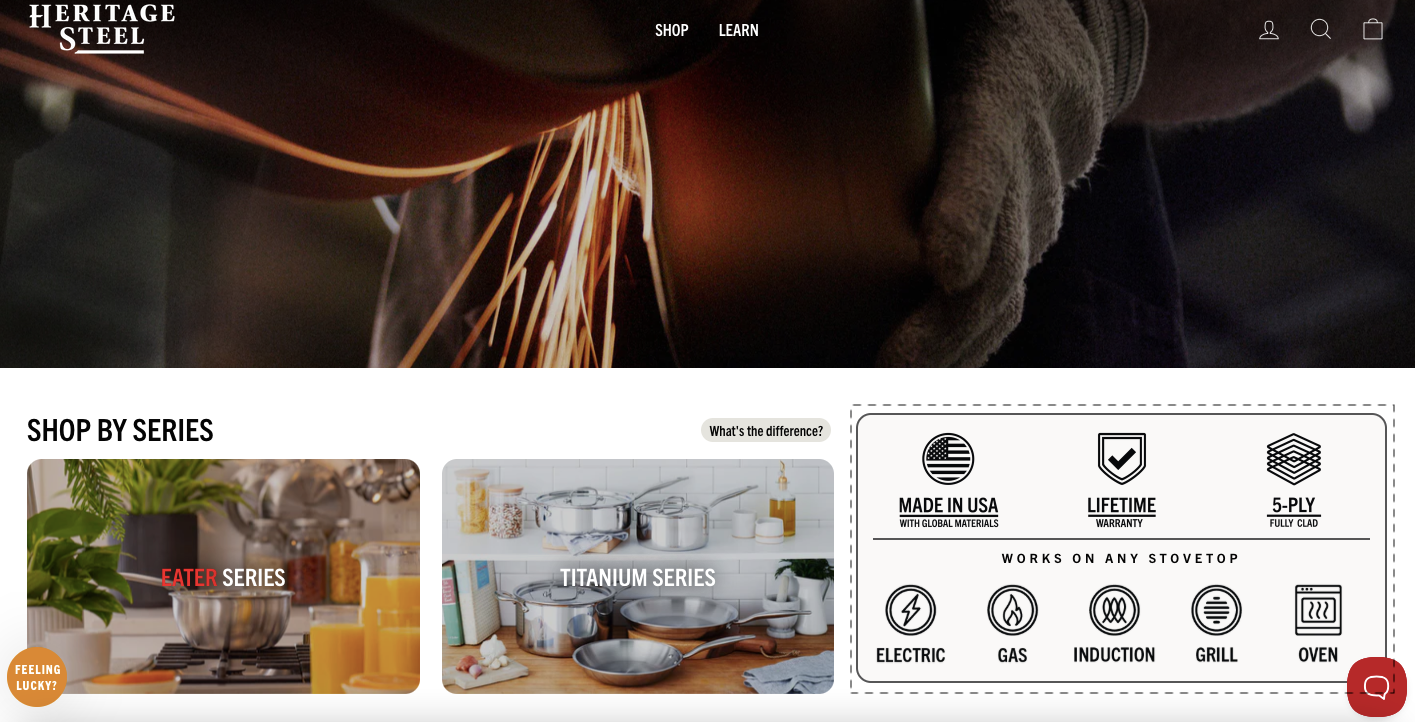
Further Reading: 30 Ways to Build Trust FAST (On Your eCommerce Store)
Let’s get this straight: cookware, kitchenware and bakeware in eCommerce are super technical categories.
And more often than not, they’re also longer lifecycle products — which is why if you have to sell more in the longer run, you’ll have to make it easy for return customers to look for replacement parts & accessories.
Here’s how to get this cookware conversion rate tactic right:
✅ Show contextual add-ons on product pages — for example, if the main product is a saucepan, you may want to create a separate section within the product card to show matching lids. If there are color variants, ensure to use a separate swatch section too (but don’t exceed 4 to 5 kinds to reduce choice overload). Add a “Looking for replacements?” section for returning customers.
✅ Suggest accessories immediately after purchase — show a pop-up on the order confirmation page where the most relevant accessory is featured (our suggestion? Skip showing more than two accessories at this point). For emails, send one a day or two after the purchase, and ensure to feature a separate category on replacements at the top for easy locating.
DTC cookware brand Ninja Kitchen maintains a separate parts & accessories hub for good reason. Since this is clearly visible on the homepage, the brand is able to create an immediate discovery path for existing customers. What’s even better, they feature multiple ways of finding the right parts & accessories once shoppers are on the page:
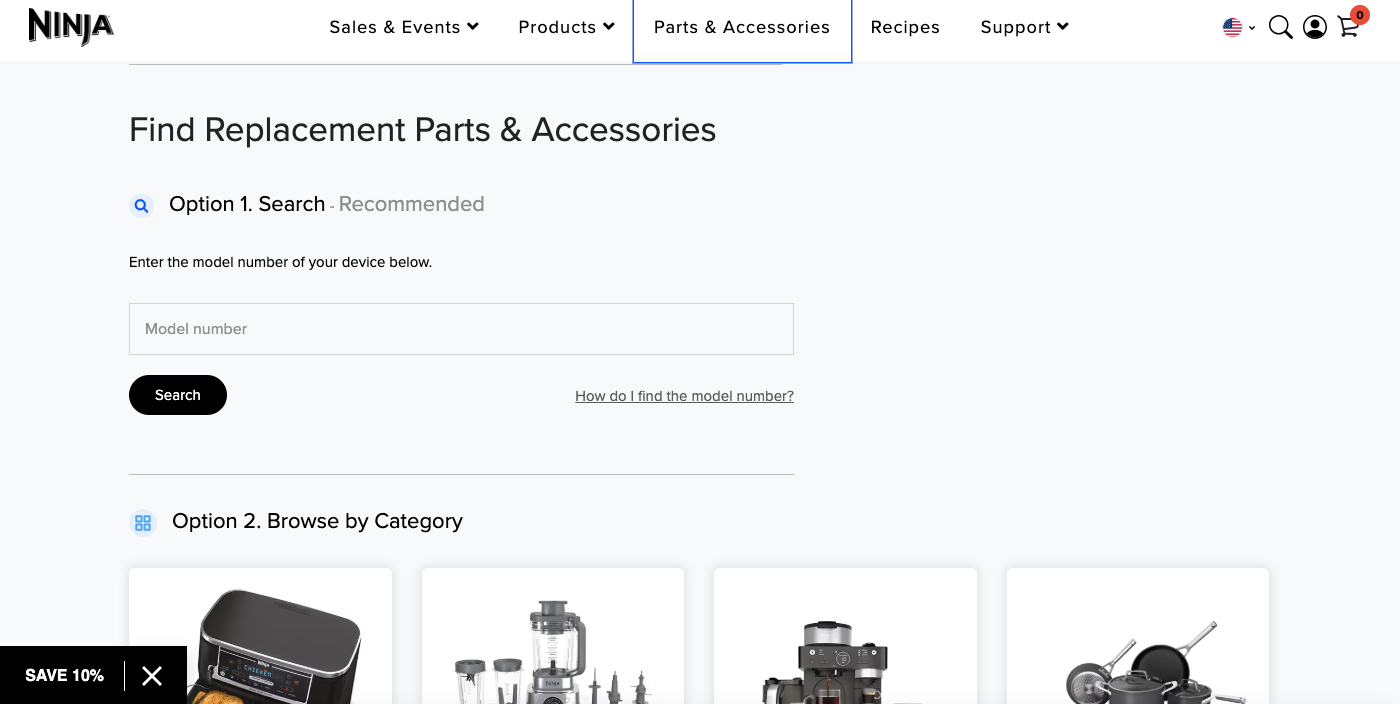
Further Reading: 33 Scientific Ways To Improve eCommerce Product Discovery
While this may sound like you’re neglecting shoppers with early awareness or growing consideration, nudging the bottom of the funnel is an easier way to sell for any cookware DTC brand.
This is simply because most cookware make up for high-consideration purchases — so what would usually drive a $40 product forwards, doesn’t apply here.
And that means how you resonate with the needs of shoppers who have a real desire to buy, is critical.
✅ Give special attention to returns & warranties — whether it’s in the main menu or in the footer, shoppers on the brink of buying should be able to see these critical pieces of info very easily. For example, some brands bring up “warranty registration” to the top menu in a location that doesn’t compete with important categories (preferably the top right, beneath the account / profile functionalities)
✅ Use urgency without pushiness — to show urgency like “only 5 pieces left” on a $399 dutch oven is a massive cookware conversion mistake. Instead use such information to maintain a healthy level of desire, something like “1243 people have viewed this product in the last week” is more believable & convincing.
✅ Use quick checkout buttons — shortening the checkout path is one of the easiest ways to win over cookware customers time and again. So, for example, if you run a Shopify store, ensure you have ShopPay as a CTA on product pages. Also across platforms, mobile payments need to include OTP-led guest checkout.
Founded in Brazil in 1911, cookware brand Tramontina is known for its long line of tableware, cookware and cutlery. But where this brand aces is targeting cooking pros and chefs. To ensure easier product discovery for this customer segment, they’ve created a “chef’s tools” section in their primary navigation:
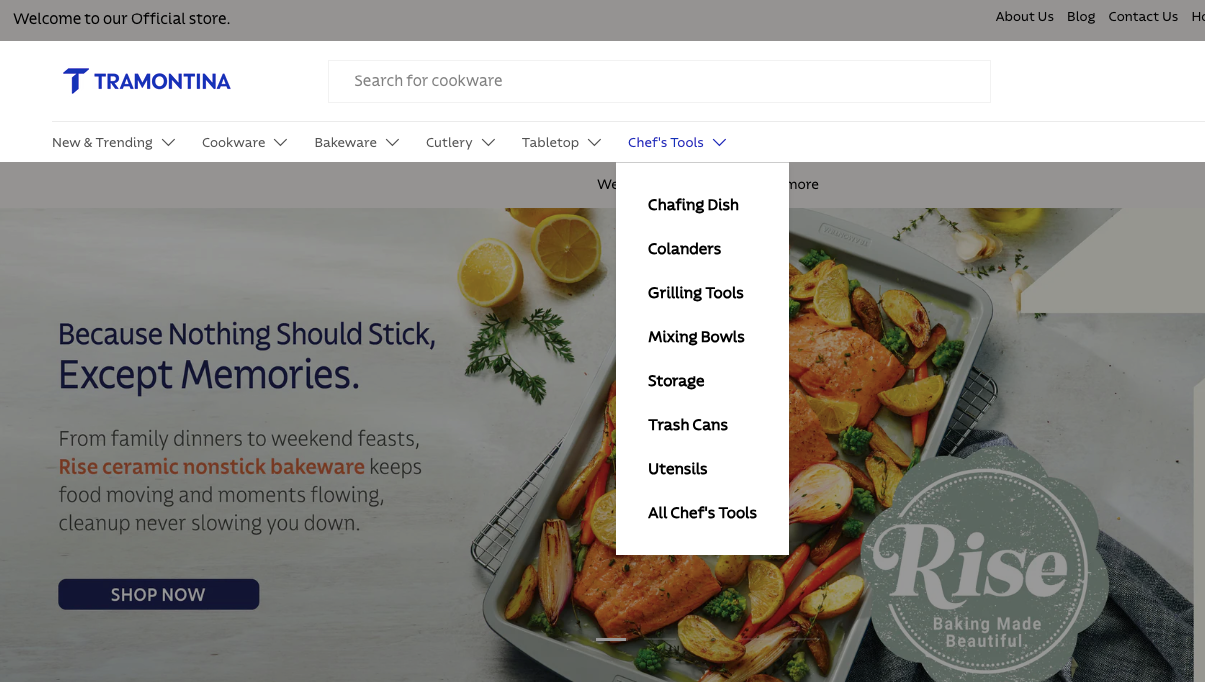
Thoughtful purchases drive most eCommerce cookware sales.
And that means how you enable shoppers to do research in-store can make or break how confident they feel about, say, a saucepan set from your brand.
This is why featuring comparison charts on your cookware product pages, becomes an absolute must.
However, what you include in it can drive more value or not — so here’s how this cooking store conversion optimization can really work:
✅ Show brand-level differentiation, not just feature-level — this is crucial especially if you’re a player in a more popular sub-niche like all-steel cookware where subtle but strong differentiation can help shoppers pick your brand over others
✅ Feature technical depth but balance it with real-life terminology — for example, “number of plies” is highly technical and because of that, most shoppers would also like it if you layered it with something like “best for searing”.
GreenPan is an eCommerce brand that stands by “healthy ceramic nonstick” products, something they’ve been at since 2007. This is a brand that takes its comparison charts rather seriously and if you’re a product explorer with intent, you’ll find they create different charts for each category. But the common theme is highlighting the key differentiators of their own products and then driving them in comparison to competitor brands & niches:
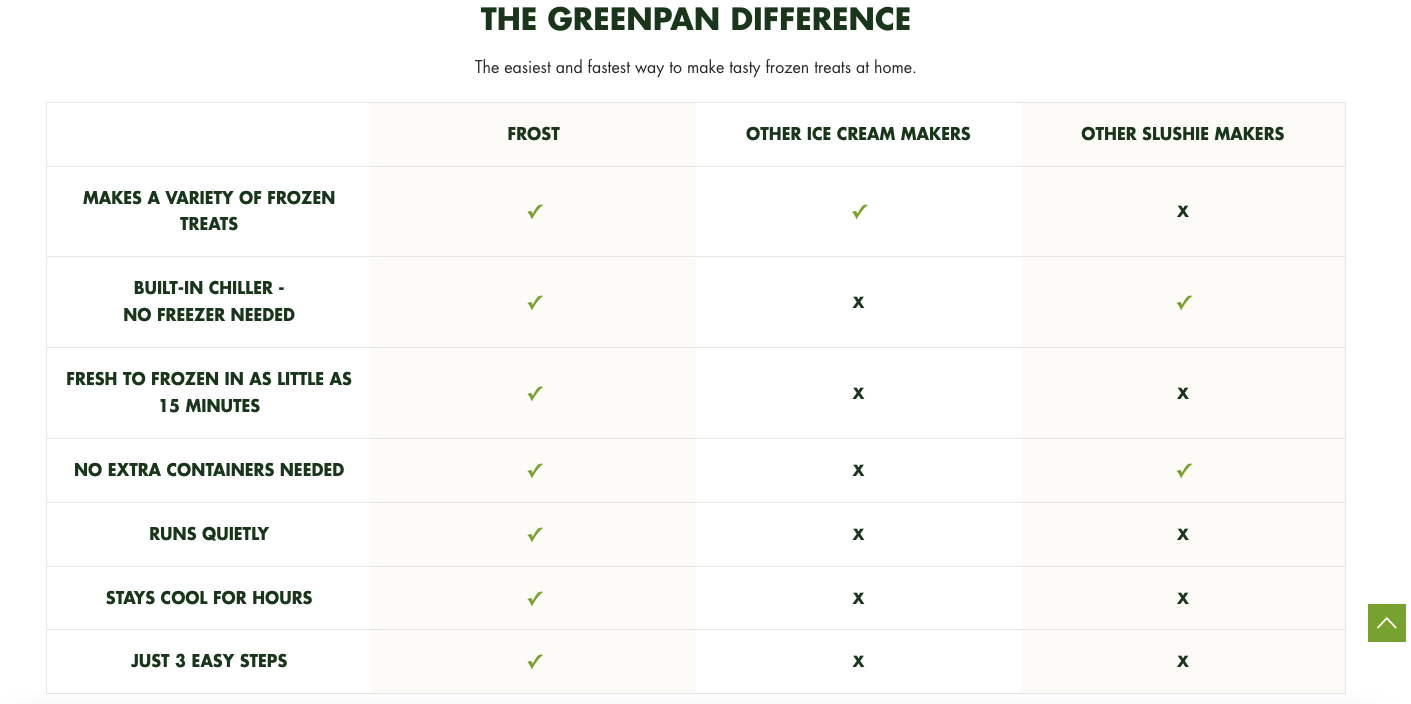
You may want to read: 15 Critical Steps In eCommerce Competitor Analysis
To sell cooking equipment online, it’s a given that you need rich recipe content.
It’s a way to get your organic traffic coming in as well as tilting SEO in your brand’s favor.
But the best cookware brands in the US have figured that recipe content is just the thing to leverage and recommend products — here’s how to get it right.
✅ Use user generated content that mimics native brand content — well-shot video content and use case shots work the best for this. In case of video, pushy marketing would be if the voice-over explicitly keeps stating the name of the products in use. Instead: recommend products of the same color & design variations as shown in the UGC - this speaks quietly but strongly.
✅ Pair recipes with only select products — in our conversion optimization experience, do this only when you have limited edition items and curated bundles to feature. Since these are likely to be considered by more shoppers, a recipe + recommendation pairing can often act as the final nudge before the purchase.
✅ Focus on teaching a technique — this grabs serious shoppers through their emotional connection with the cooking style or event-based specialty. When you pair such a recipe casually with a recommendation, it tends to work better.
eCommerce DTC cookware brand uses the above cookware conversion rate optimization strategy in multiple ways. For one, they bring in native-looking video content for specific bundles, ensuring all the products are listed individually alongside the recipe content:
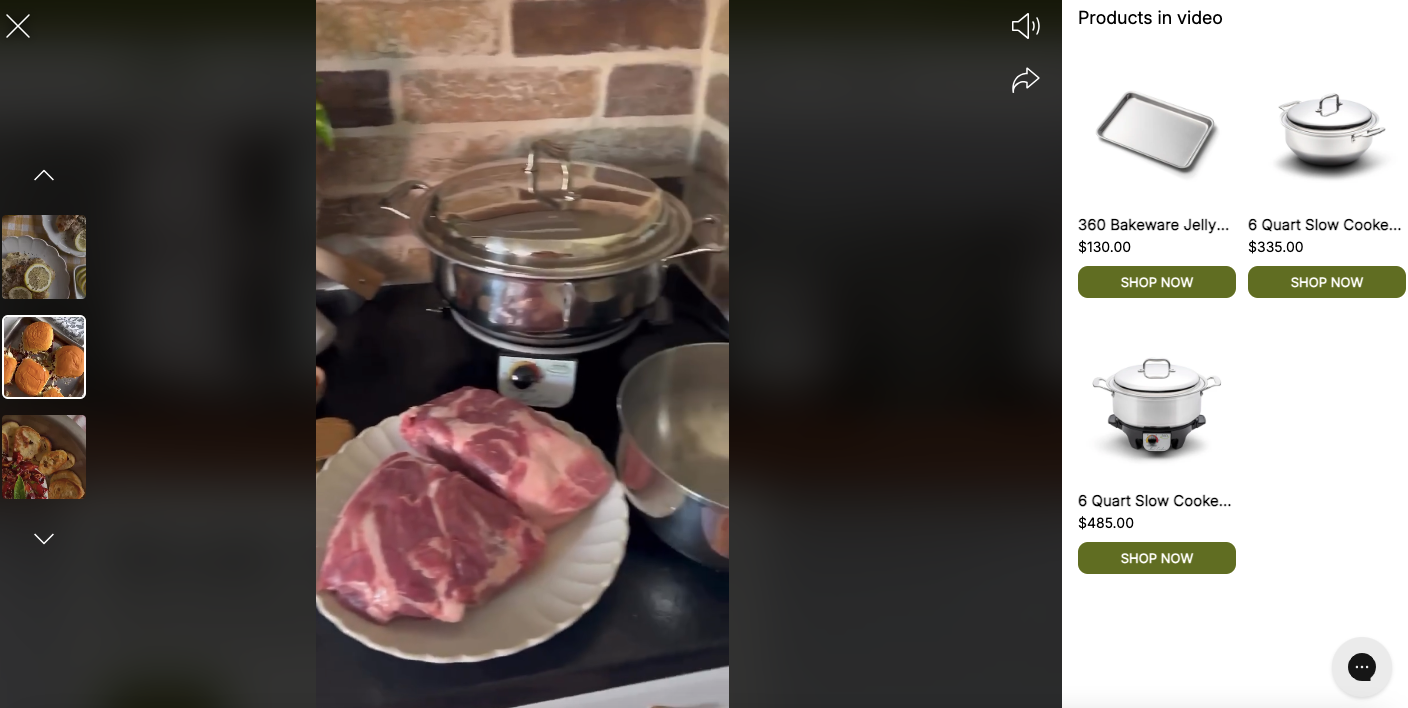
On the other hand, for their blog-based recipes, they ensure to link the specific product page(s) even before diving into the full-length content:
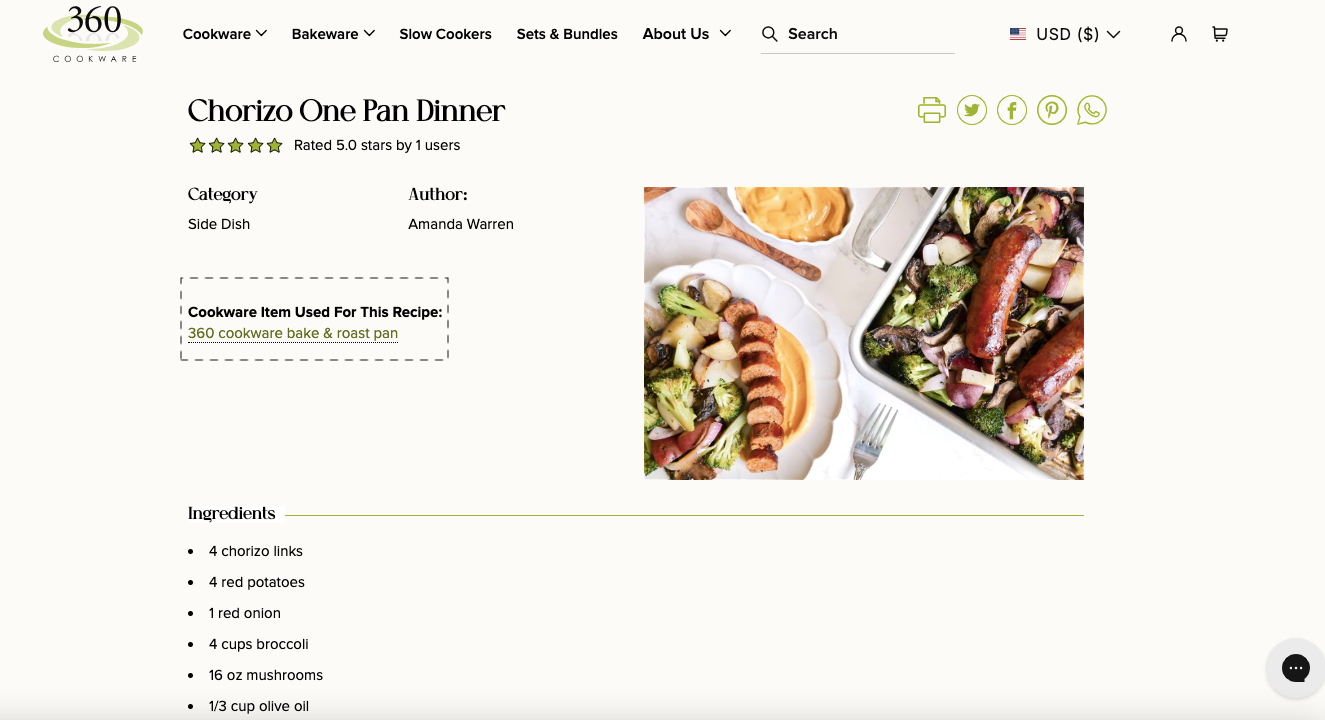
In eCommerce, across niches, it’s clear that add-ons are a great way to increase average order value and enhance overall customer experience.
But several cookware brands we’ve audited have made the mistake of citing add-ons right within the product card under the product page CTA — just like any other niche would.
For cookware conversions, this may not work all that well because shoppers are unlikely to add even a $100 without fully understanding how it can enhance the cooking experience over and above the main displayed product.
✅ Show a distinct product page section (but ensure there are CTAs) — use this as an additional information section right after the first fold in the product page gets over, so that relatability with the main product is still high.
✅ Surface a line on each add-on upon hover in the cart — this can be a game-changer especially for shoppers who’re casually adding to cart, flipping back and forth between items etc. Use the prime USP of the product in question to craft the one-liner.
✅ Place add-ons under a “Limited Edition” category page — this is a key way to ensure add-ons are really noticed and not simply scanned past. Since cookware is usually high-consideration, a $60 product against a primary that costs, say, $300 might not hold all that attention. But if you push 15 of these into a separate limited edition page, they’re likely to get a lot more traction.
Great Jones does this really well, and what helps them is they often do cross-brand collabs:
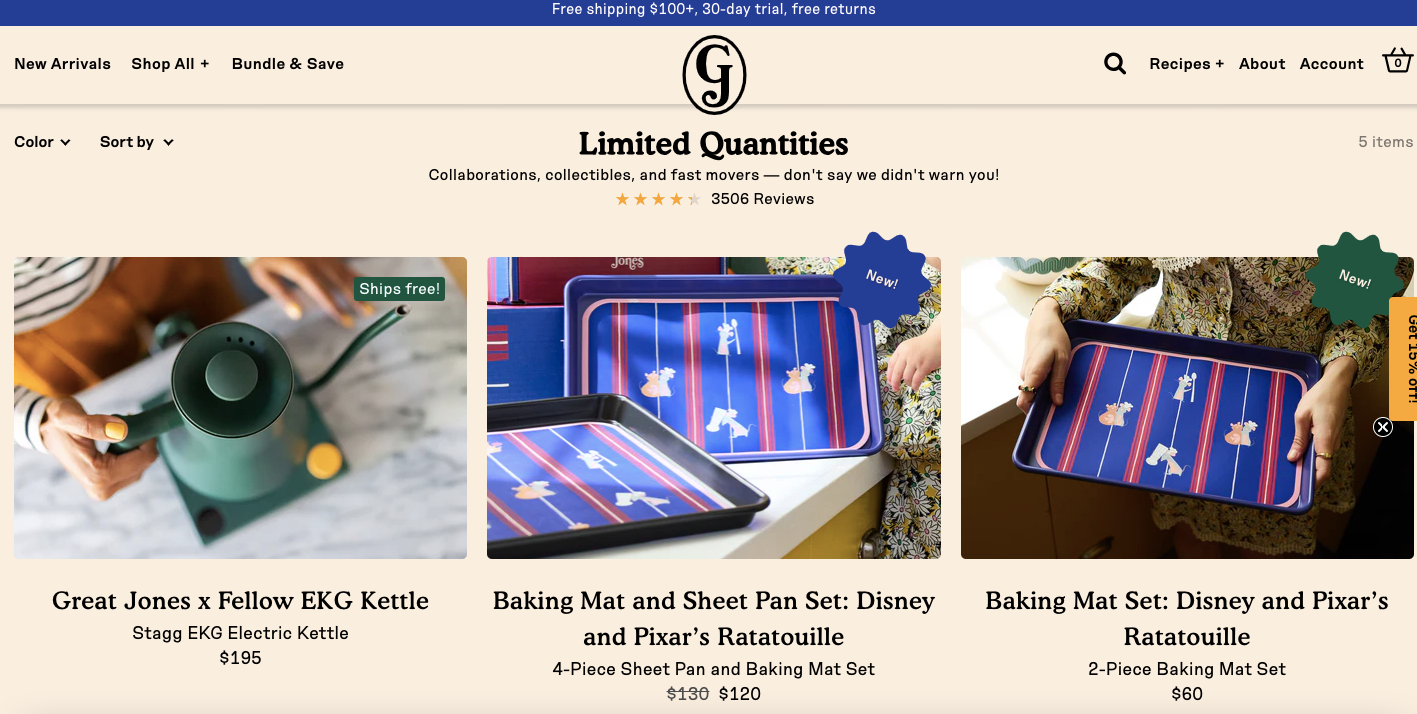
Our Place has a non-pushy way of marketing cookware add-ons. They offer elaborate information on each add-on both through text and visuals and through a toggle setup so that shoppers can view one after the other. The only thing we’d recommend they do is to add a call to action to each add-on:
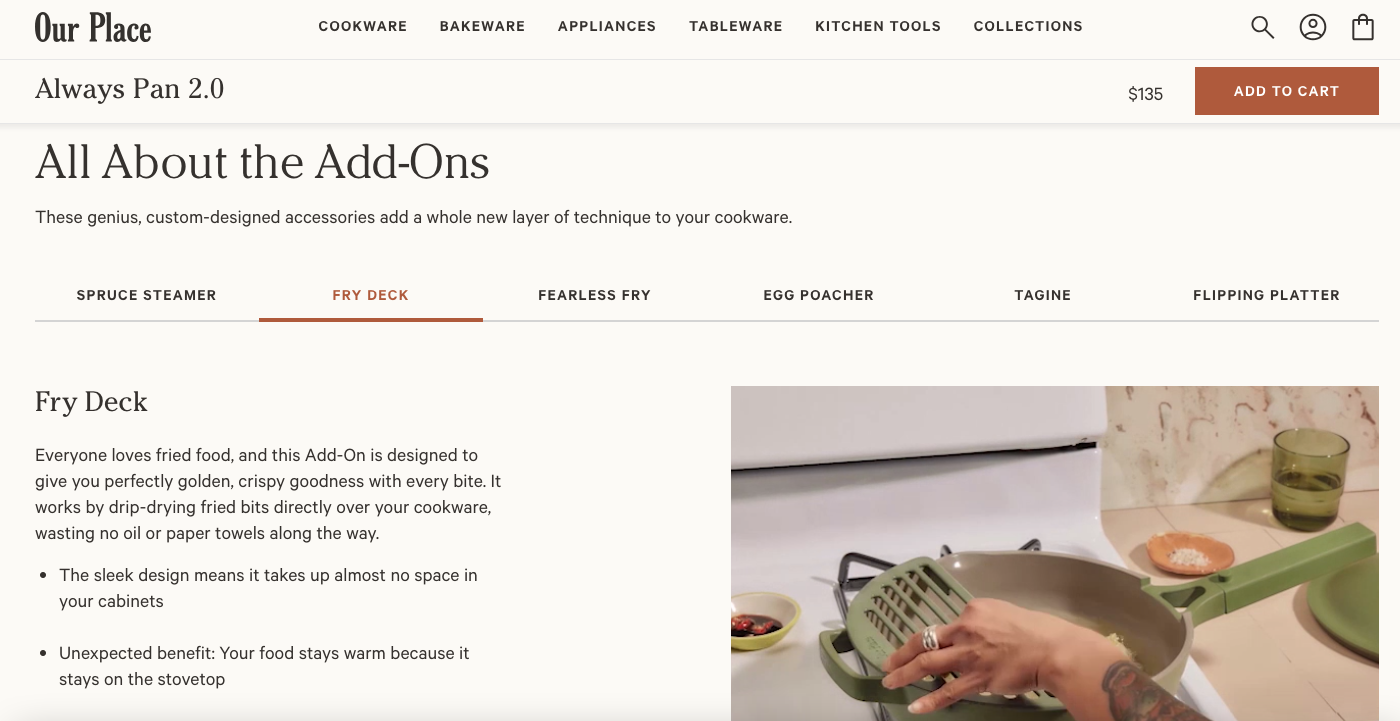
Selling cookware is a high-stakes game — if you’re good at it, you’ll have the luck of selling more in the future, because shoppers like to come back to favorites when higher investments are involved.
And that brings us to the factor of priming. With a distinct cart icon or drawer, you can visually prime shoppers who’ve landed, to move towards a purchase.
This is a way to get them to think, “I’ll be adding things here soon,” and continue their product exploration on that note.
To get this cookware brand conversion optimization right:
✅ Warm it up with some inviting hint text — something like “Your kitchen upgrade starts here” can prime shoppers even further psychologically
✅ Feature a progress indicator — most cookware buyers are keen on receiving free shipping because prices are anyway on the higher end. And for special sales or holiday marketing, you can even introduce free gifts into the thresholds to drive higher AOV
✅ Make it sticky — this way adding to cart becomes a top of the mind action item, even if you have a high-intent ToFu shopper discovering products across your cookery store.
Legacy is the other name for eCommerce cookware brand Alva, which began its operations in 1949, and would create cookware from discarded wartime materials. Along with leveraging a sustainable back-end process, Alva also ensures they prime customers through a sticky cart icon.
When opened there’s friendly hint text waiting that prompts buyers to fill their cart, along with recommendations that feature CTAs highlighting free shipping. By doing all of this, Alva ensures it drives priming in three different ways: visually, through a goal (notice that progress bar on top?) as well as by citing clear value (free shipping):
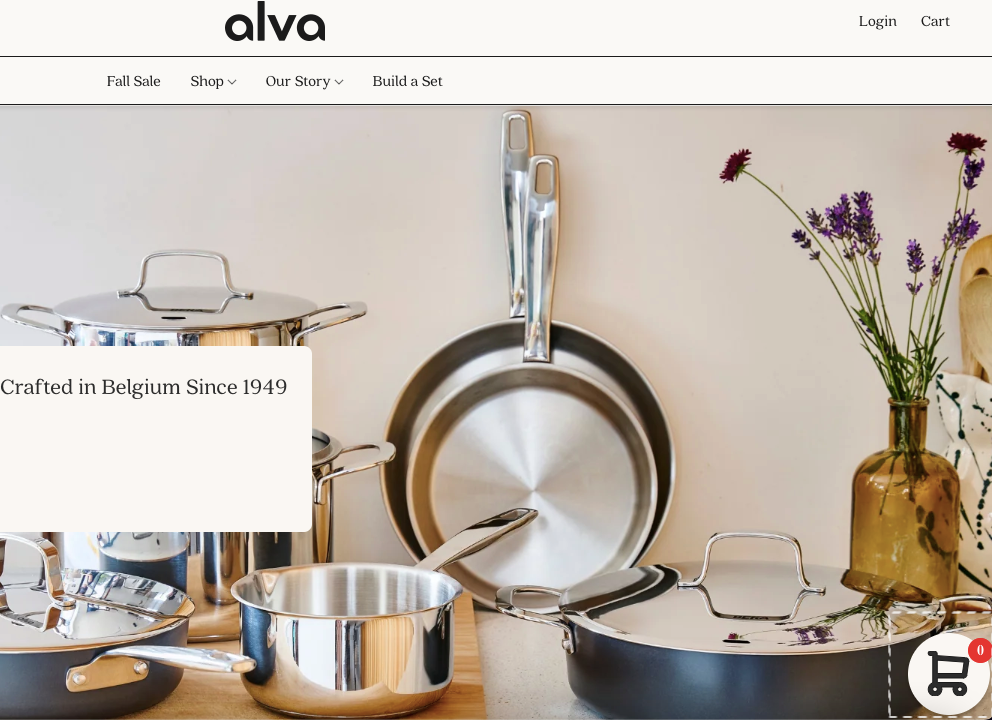
The world loves to eat — but it loves to eat a lot more during peak holiday season.
And that means your cookware conversion optimization strategies need to be able to make space for this condition.
Whether it’s 4th of July or Thanksgiving, how your cookware store positions products as “limited edition”, truly decides how well it will sell.
✅ Highlight the limited stock — it’s ideal you feature this on the homepage hero banner and also run ads with the stock number, something like “200 limited edition non-stick saucepans just out — get yours before they’re gone!”
✅ Tease the release only to loyalty members — in this case, cite a low number like 50 pieces so that both urgency and exclusivity make a heady mix. And ensure the promotions happen through email, SMS as well as push notifications.
Modern cookware brand Caraway is known for their special edition bundles, which not only make it to the main store website but also to expert listings across press like Architectural Digest. The brand is known to survey shoppers seriously and take their feedback into account when coming up with limited edition bundles.
For example, when they came up with their limited edition bundle in 2021, they sought active feedback from shoppers and found that the latter were eagerly looking for new colorways. The holiday edition featured the full suite of Caraway cookware including a saucepan, a fry pan, sauté pan and also a Dutch oven.
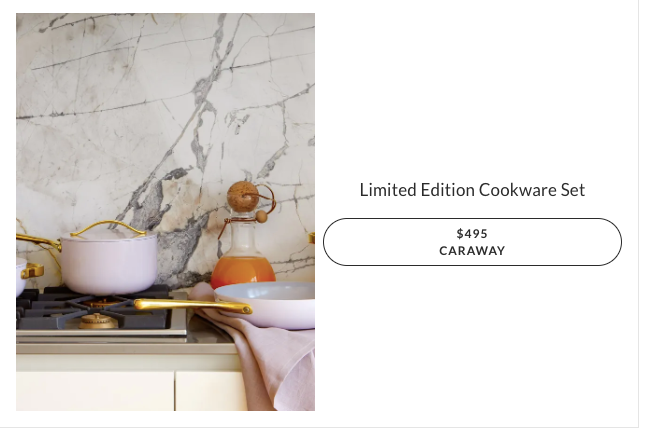
It’s simple: because cookware and kitchenware items tend to be more expensive, high-intent shoppers have a tendency to prefer bundles.
But while a “bundle and save” hook can be instrumental in bringing back return customers, a more nuanced bundling strategy that has tiers may be more ideal across the conversion funnel.
The idea here is to look at the cooking enthusiast and then create sub-segments.
✅ Entry level bundles for beginners — the idea is to set a competitive price and take off the cooking woes of students, people on their first job or even those who’re tired of a super basic and disjointed cookware experience
✅ Mid-tier bundles for performance lovers — yes, those home cooks who’ve been at it for a while and are now ready to create and distribute their own content or amp up the number of people they can host at a time. Either way, this is a great cookware conversion opportunity.
✅ Premium bundles for collectors & high-flying professionals — this is your chance to charge higher for a 6-piece set even if you have a similarly numbered entry set. Just ensure this is a feature and design rich experience that’s worth talking about.
Read more: 15 Product Bundling Examples That Convert (& 9 Proven Ideas)
Cookware brand Made In, which believes in offering direct to consumer prices on their high-end steel kitchenware, created a tiered stainless steel bundle - for beginners, it was a 6 piece set, for mid-tier shoppers, a 10 piece set and for professionals, a 13 piece set. It even made to several high profile publication lists, including that of the New York Mag.
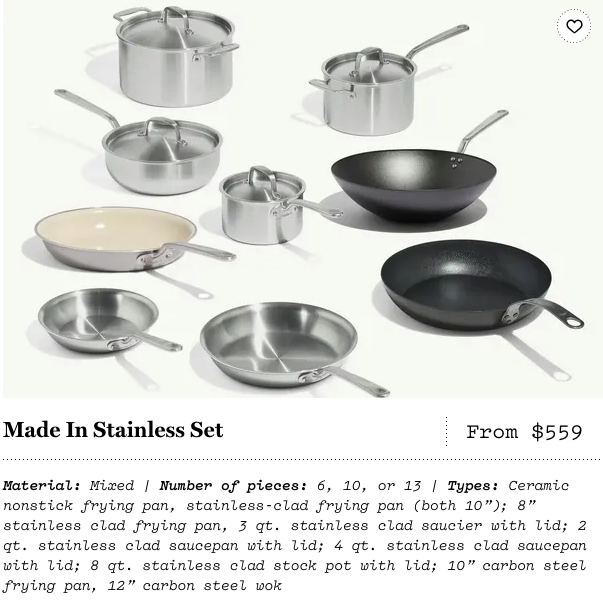
Back in the day, cookware stores were seen as functional places to shop.
But over time, eCommerce DTC stores have managed to turn this around by creating content around the community that makes the experience more aspirational.
This is a cookware conversion strategy that you need to include too, and here are a couple of suggestions.
✅ Create subscriber-only cook-alongs — featured that segmentation pop-up to grow your email list? Now it’s time to deliver content to these subscriber bases that will foster the sense of community. Feature gated content like cook-alongs but offer free access to those who’re on your email subscriber base.
✅ Feature aspirational giveaways on the store — like that trip with a celebrity chef or a $X worth bundle featuring all-time favorites across the years. This can achieve great virality as peak season selling approaches and more visitors become naturally more amenable to buying. This way you can let people enter the contest by buying and showing the number of entries as badges for each product, driving further community engagement.
Cookware brand Babish puts a price tag on community content — and for good reason. When paying for it is involved, more shoppers and browsers end up engaging more actively. A tiered approach also helps the brand target different customer intent more effectively.
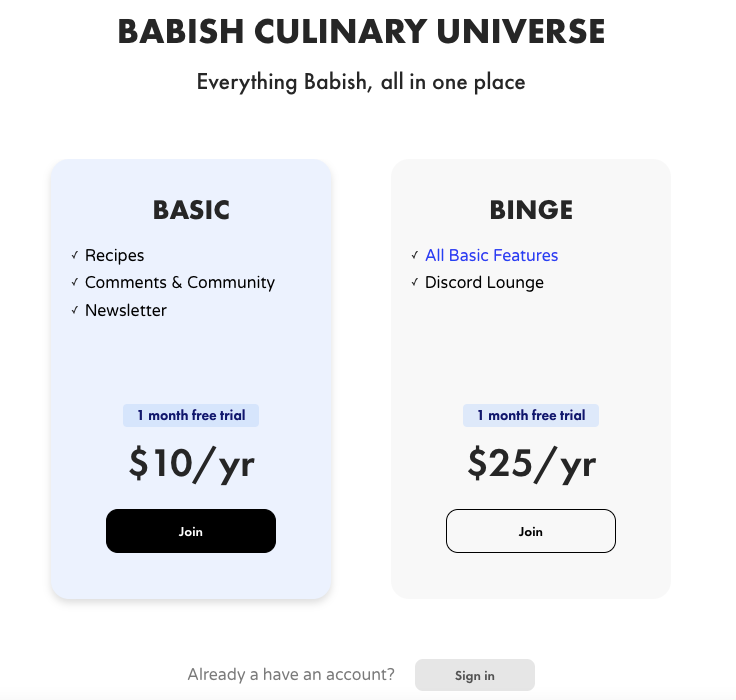
Further Reading: 14 eCommerce content marketing mistakes (+ their fixes)
While it’s great that you’ve been trying to convert individual customers on your eCommerce cookware and kitchenware store, going that extra mile of incorporating wholesale & customer enquiries might be the next step.
Since cookware items typically have a longer lifecycle, this conversion strategy will ensure you sell more — and to those who already need it more.
✅ Build a dedicated landing page for wholesale / custom enquiries — even if you have an easy-to-access link in the footer, professionals need to know a this option exists apart from your standard sets, bundles and recommendations. Our suggestion? Design a distinct section somewhere mid-scroll on the homepage and ensure there’s a highlighted item in the main menu.
✅ Segment serious leads more carefully — create tiers of incentives as far as order numbers go. Offer volume-based perks like free shipping over 50 units, custom engraving for orders above 100, dedicated support for large accounts.
✅ Feature relevant social proof — this is where you need to feature your authoritative social proof, ideally from a chef, restaurant or other hospitality business that has been wowed by quantity purchases or products with custom engravings.
Cookware brand HexClad clearly targets restaurants through a dedicated landing page and an easy-to-fill form. A section on the USP of HexClad products ensures high-intent customers find a bigger reason to pursue their consideration — and social proof from real chef-run restaurants make it real:
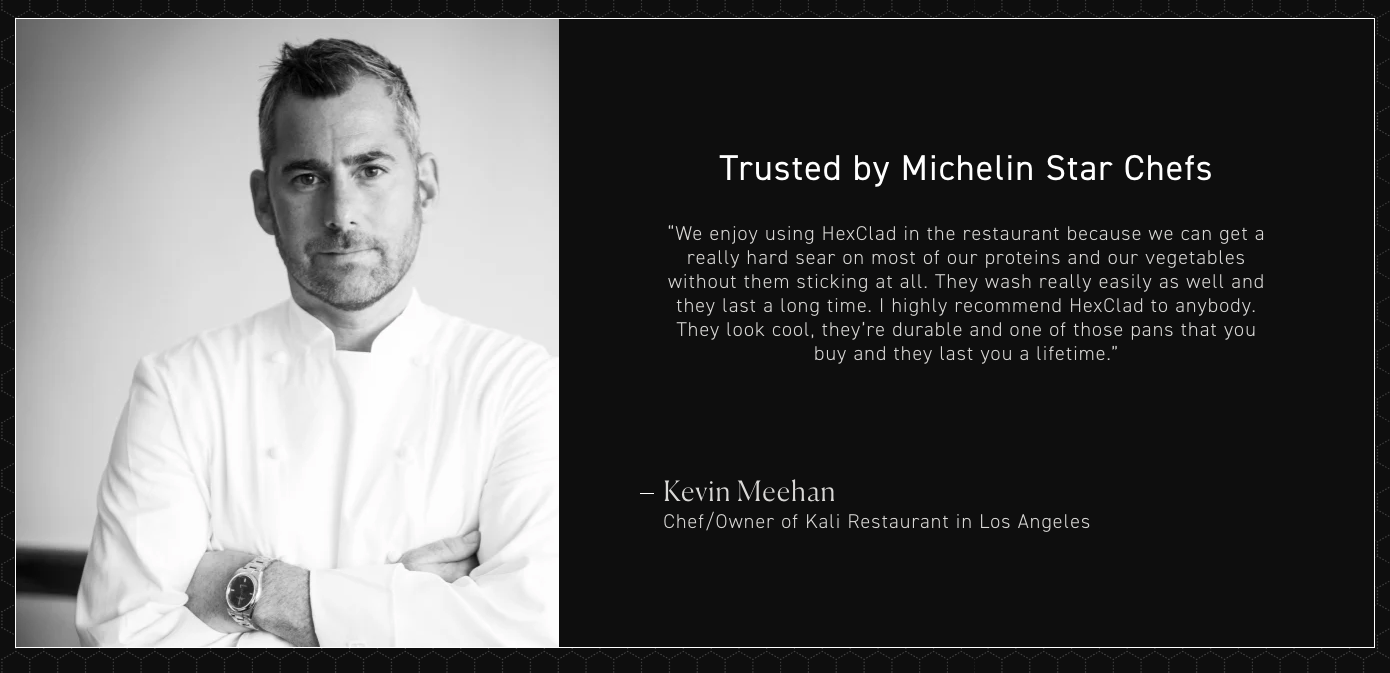
While it's mighty important that you convert well on your cookware and kitchenware store, it's even more critical that you know how to maximize profits at every step. We feature a breakdown here of the 3 aspects we've seen to work best for clients in this eCommerce niche.
This one's right at the top of the cookware profit strategies because we've seen what a key difference it can make. For example, it's always a better idea to place hero bundles over individual product listings if you want more shoppers to engage with them.
In terms of placement, to improve cookware conversions, the key locations to highlight bundles include the homepage hero banner, the space beneath the add-to-cart button on the product page and on the cart page / drawer, as upgrade nudges to the main order summary.
Pro Tip: Run the test for at least 2 full buying cycles, as cookware is a longer lifecycle niche. And never run a particular test on multiple placements at the same time.
Keep Reading: 153 A/B Testing Ideas for eCommerce (Homepage, PDP, Cart, Checkout)
Across cookware and kitchenware clients, we've noticed hero products moving conversions even during the relatively lean buying seasons. But to get this factor right, it's essential to set rules for which products can essentially make it to the hero product list. Here are a few markers:
As much as cookware brands can reap the advantages of sending post purchase emails immediately after purchase, the real work needs to go into nurturing the shopper through the product's entire lifecycle. Here are a few other aspects to lay focus on:
Cookware can be a tough niche to crack given that 98% of visitors who visit an eCommerce site—drop off without buying anything.
Even if your products are durable and dependable
Why: user experience issues that cause friction for visitors.
And this is the problem Convertcart solves.
We've helped 500+ eCommerce stores (in the US) improve user experience—and 2X their conversions.
How we can help you:
Our conversion experts can audit your site—identify trust issues and suggest changes to improve conversions.
And we won’t charge for this one.